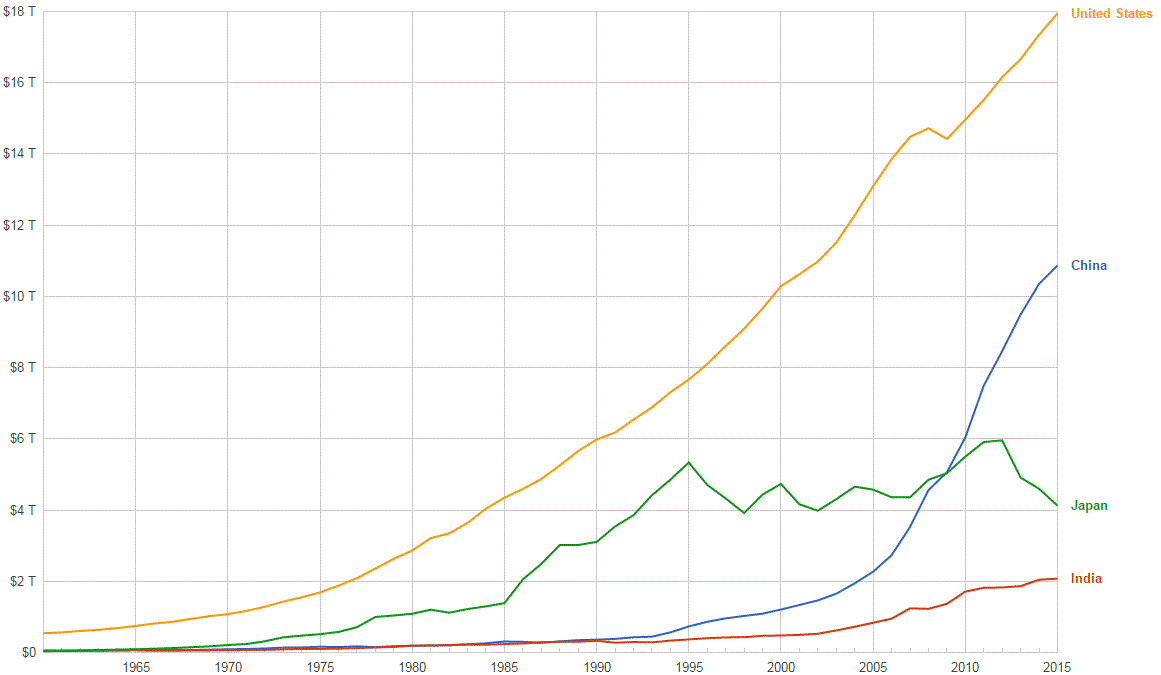Now, the Chinese economy has been on a tear for the last three decades. This graph cribbed from Wikipedia nicely shows this trend:

It was doing double-digit growth rates and is still growing 6-7% a year. As I point out in my previous blog posts, the Chinese armed forces are not really ready to invade a defended Taiwan, especially their air force and navy. This is going to take some time and money to build up.
Such a build up sort of means that the economy needs to keep growing. Hard to justify lots of nice new shiny expensive high-tech airplanes when the economy is in the doldrums. As the economy has been steadily growing at 6% or more a year for 30+ years, their definition of doldrums may be pretty slanted.
Now, relatively speaking, the Chinese have not been putting as much into defense as either Taiwan or the United States. Their defense budget is between 1.3% to 1.7% of their GDP. In contrast, the U.S. defense budget is between 3.4% to 3.7% of its GDP. Taiwan’s defense budget is around 2.3% of their GDP. As the Chinese economy grows, so to will their defense budget; I suspect we will know they are serious about changing the status of Taiwan if and when their defense budget expands to 2 or 3% of GDP.
But, the big question is whether the Chinese economy is actually going to keep expanding at 6% a year. A lot of people have been questioning that for a while, some people have been predicting that China is heading for an economic crash, some people have been claiming that the economy is artificially boosted, and other people are claiming that their economic statistics are artificially boosted. Regardless, they are facing a changing economic environment with India and other countries taking over the “cheap manufacturer” role. The transition to a more developed and growing economy could be a little fraught.
There is one big ticking time-bomb the Chinese are facing, which is their demographics. I have blogged about this before (see below). The birth rate of China is below replacement rate, so the population is aging and the number of new young workers is declining. Old people are less productive and because of their health problems, sometimes more expensive. This is an economic drag with all aging populations unless one comes up with a Logan’s Run type solution. But, even a bigger problem will be the declining young work force. This is in part, a problem created by the one-child policy of China, which had good short-term benefits but has now created a long-term problem. Most likely the Chinese population will experience negative population growth by 2030. The population for China for 2021 is estimated at 1.44 billion. The United Nations predicts the Chinese population will be 1.36 billion by 2050. The real shortfall will be in the number of new workers.
Now, China is reacting to that with a new three-child policy. An article on that is below. China abandoned is one-child policy in 2015 (much too late in my opinion), went to a two-child policy and now have upgraded to a three-child policy. What is next: do they all become Mormons? This does look like an exercise in desperation. But, regardless of what the Chinese government does, I don’t think we are going to see a sudden sea-change in Chinese demographics over the next twenty years.
So, if the population starts declining by 2030…then does the economy decline with it? I think it will slow economic growth down. Hard to imagine they can maintain their 6% growth rates in that environment. They appear to have no quick and easy fix.
Now, a slow growth, stagnant or declining economy creates all kind of new problems. First, it is hard to increase or justify defense expenses when the economy is stagnant. If they are serious about creating the modern air forces and navy that they need to invade Taiwan, then they need to go on a spending spree for a decade or so. Chinese is looking at the population starting to decline by 2030. In 2020 they only had 12 million new births. By 2025 they will have over 300 million people over the age of 60. Does this mean that they have already “lost the bubble” for the chance to build up their military so as to take Taiwan?
Second, invading Taiwan is going to have a big negative economic impact. I have discussed this before, with perhaps a loss of 60-80% of their trade, 60% of their oil and a decline in their economy of 30-40% (just a guess). See the post below.
Third, stagnant or declining economies tend to lead to demands for political reform. This leads to either governmental reforms, leadership changes, civil unrest or even overthrow of the government. It was the extended period of economic stagnation that set the stage for the overthrow of Communism in Russia. We did go from a world in 1991 that had 16 Communist governments to a world with only four (China, Cuba, Vietnam and North Korea). Is this the final stage of that movement? One cannot rule it out. Hard to imagine the leadership of China is going to be focused on invading Taiwan if they are facing another Tiananmen Square (1989)
That said, there is a risk here in the danger to the government. Argentine invaded Falklands Island in part due to concerns about unrest in Argentina. In a sense, it was an invasion conducted for the sake of trying to bolster the government. This may not be a good example for China to follow, for not only did Argentina loose the war, but the government was overthrown and the leaders were arrested. The head of the Argentine junta was sentenced to a dozen years in jail.
There is another example of a booming Asian economy that was going to surpass the United States. This is Japan. I have blogged about this before. To summarize: In 1995 the Japanese economy was 71% of the U.S. economy based upon GDP. In 2017 it was 25%. I always liked this graph from that blog post:

Does history repeat itself?
Previous blog posts:
Invading Taiwan in the next six years – the fight? | Mystics & Statistics (dupuyinstitute.org)
Proposed Defense Budget for 2022 | Mystics & Statistics (dupuyinstitute.org)
Demographics of China | Mystics & Statistics (dupuyinstitute.org)
“We can’t afford it”: Chinese internet users have rejected Beijing’s new three-child policy
Where Did Japan Go? | Mystics & Statistics (dupuyinstitute.org)
P.S. Chinese economy grew 6.7% in 2018, 6.0% in 2019, 2.3% in 2020 and is projected to grow 8.5% in 2021 (source: World Bank and for 2021 IMF). In contrast, the U.S. economy grew 3.0% in 2018, 2.2% in 2019, -3.5% in 2020 (it shrunk), and is projected to grow 6.39% in 2021 (source IMF).
P.P.S.: A recent article on Chinese demographics that repeats what I have been saying: https://www.reuters.com/world/china/china-2020-census-shows-slowest-population-growth-since-1-child-policy-2021-05-11/

